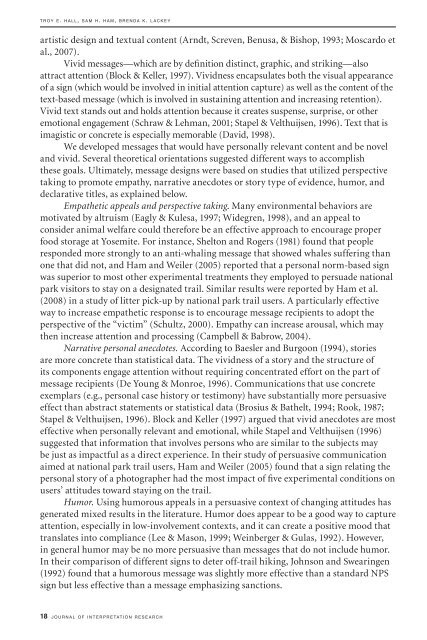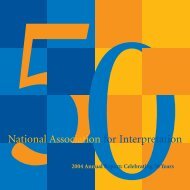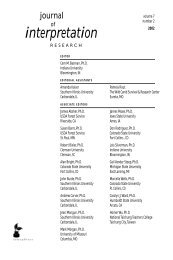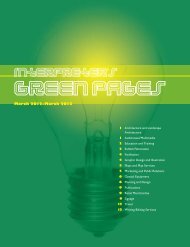interpretation
Volume 15, Number 1 - National Association for Interpretation
Volume 15, Number 1 - National Association for Interpretation
Create successful ePaper yourself
Turn your PDF publications into a flip-book with our unique Google optimized e-Paper software.
t r o y e. h a l l , s a m h. h a m , b r e n d a k. l a c k e y<br />
artistic design and textual content (Arndt, Screven, Benusa, & Bishop, 1993; Moscardo et<br />
al., 2007).<br />
Vivid messages—which are by definition distinct, graphic, and striking—also<br />
attract attention (Block & Keller, 1997). Vividness encapsulates both the visual appearance<br />
of a sign (which would be involved in initial attention capture) as well as the content of the<br />
text-based message (which is involved in sustaining attention and increasing retention).<br />
Vivid text stands out and holds attention because it creates suspense, surprise, or other<br />
emotional engagement (Schraw & Lehman, 2001; Stapel & Velthuijsen, 1996). Text that is<br />
imagistic or concrete is especially memorable (David, 1998).<br />
We developed messages that would have personally relevant content and be novel<br />
and vivid. Several theoretical orientations suggested different ways to accomplish<br />
these goals. Ultimately, message designs were based on studies that utilized perspective<br />
taking to promote empathy, narrative anecdotes or story type of evidence, humor, and<br />
declarative titles, as explained below.<br />
Empathetic appeals and perspective taking. Many environmental behaviors are<br />
motivated by altruism (Eagly & Kulesa, 1997; Widegren, 1998), and an appeal to<br />
consider animal welfare could therefore be an effective approach to encourage proper<br />
food storage at Yosemite. For instance, Shelton and Rogers (1981) found that people<br />
responded more strongly to an anti-whaling message that showed whales suffering than<br />
one that did not, and Ham and Weiler (2005) reported that a personal norm-based sign<br />
was superior to most other experimental treatments they employed to persuade national<br />
park visitors to stay on a designated trail. Similar results were reported by Ham et al.<br />
(2008) in a study of litter pick-up by national park trail users. A particularly effective<br />
way to increase empathetic response is to encourage message recipients to adopt the<br />
perspective of the “victim” (Schultz, 2000). Empathy can increase arousal, which may<br />
then increase attention and processing (Campbell & Babrow, 2004).<br />
Narrative personal anecdotes. According to Baesler and Burgoon (1994), stories<br />
are more concrete than statistical data. The vividness of a story and the structure of<br />
its components engage attention without requiring concentrated effort on the part of<br />
message recipients (De Young & Monroe, 1996). Communications that use concrete<br />
exemplars (e.g., personal case history or testimony) have substantially more persuasive<br />
effect than abstract statements or statistical data (Brosius & Bathelt, 1994; Rook, 1987;<br />
Stapel & Velthuijsen, 1996). Block and Keller (1997) argued that vivid anecdotes are most<br />
effective when personally relevant and emotional, while Stapel and Velthuijsen (1996)<br />
suggested that information that involves persons who are similar to the subjects may<br />
be just as impactful as a direct experience. In their study of persuasive communication<br />
aimed at national park trail users, Ham and Weiler (2005) found that a sign relating the<br />
personal story of a photographer had the most impact of five experimental conditions on<br />
users’ attitudes toward staying on the trail.<br />
Humor. Using humorous appeals in a persuasive context of changing attitudes has<br />
generated mixed results in the literature. Humor does appear to be a good way to capture<br />
attention, especially in low-involvement contexts, and it can create a positive mood that<br />
translates into compliance (Lee & Mason, 1999; Weinberger & Gulas, 1992). However,<br />
in general humor may be no more persuasive than messages that do not include humor.<br />
In their comparison of different signs to deter off-trail hiking, Johnson and Swearingen<br />
(1992) found that a humorous message was slightly more effective than a standard NPS<br />
sign but less effective than a message emphasizing sanctions.<br />
18 j o u r n a l o f i n t e r p r e t a t i o n r e s e a r c h












